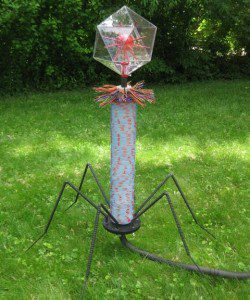

In a very simple experiment, E. coli cells carrying a plasmid encoding ampicillin resistance were infected with the well studied phages T4 and T7 and also with a collection of 20 phages isolated from soil, water, and feces in Miami and Washington DC. After the cells lysed, DNA was extracted from the culture medium and introduced into antibiotic sensitive E. coli. Two phages, called SUSP1 and SUSP2, were thousands of times better at releasing plasmid DNA that readily conferred antibiotic resistance. These phages are superspreaders.
Superspreader phages can promote transformation by different plasmids, so their unique talent is not sequence specific. When these phages lyse cells, intact plasmid DNA is released. In contrast, phage T4 infection leads to degradation of plasmid DNA in the host cell. Superspreader phages lack genes encoding known endonucleases – enzymes that degrade DNA, possibly explaining why plasmids are not degraded during infection. Other phages that lack such endonucleases, including mutants of lambda and T4, also promote plasmid mediated transformation.
Phages SUP1 and SUP2 don’t just spread plasmids to laboratory strains like E. coli. When crude mixtures of soil bacteria from Wyoming and Maryland were mixed with SUP1 and SUP2 lysates from E. coli, antibiotic resistance was readily transferred. One of the main recipients of plasmid DNA is a member of the Bacillus genus of soil bacteria, showing that superspreaders can move DNA into hosts of a species other than the one they can infect.
With so many bacteriophages on the planet, it is likely that there are many other superspreaders like SUP1 and SUP2 out there. The implication is that massive amounts of intact plasmid DNAs are being released every second. These DNAs can be readily taken up into other bacteria, leading to new phenotypes such as antibiotic resistance, altered host range, virulence, the ability to colonize new niches, and much more.
You might wonder if all that plasmid DNA, floating in the environment, can also enter eukaryotic cells – and the answer is yes. No wonder eukaryotes didn’t invent anything.

thank you for sharing this article; it is a very interesting story. I did not get if superspreaders replicate less efficiently as compaired to hydrolitic-endonuclease- encoding phage. What is the purpose of degrading host DNA anyway?
Pingback: Bacteriophage superspreaders | Media Cultures: ...
Reasons for phages to direct degradation of host DNA include to increase the pool of substrates for DNA replication, and eliminate competition for the DNA synthetic apparatus. The authors did not mention if restoring nucleases to the superspreaders would improve replication.